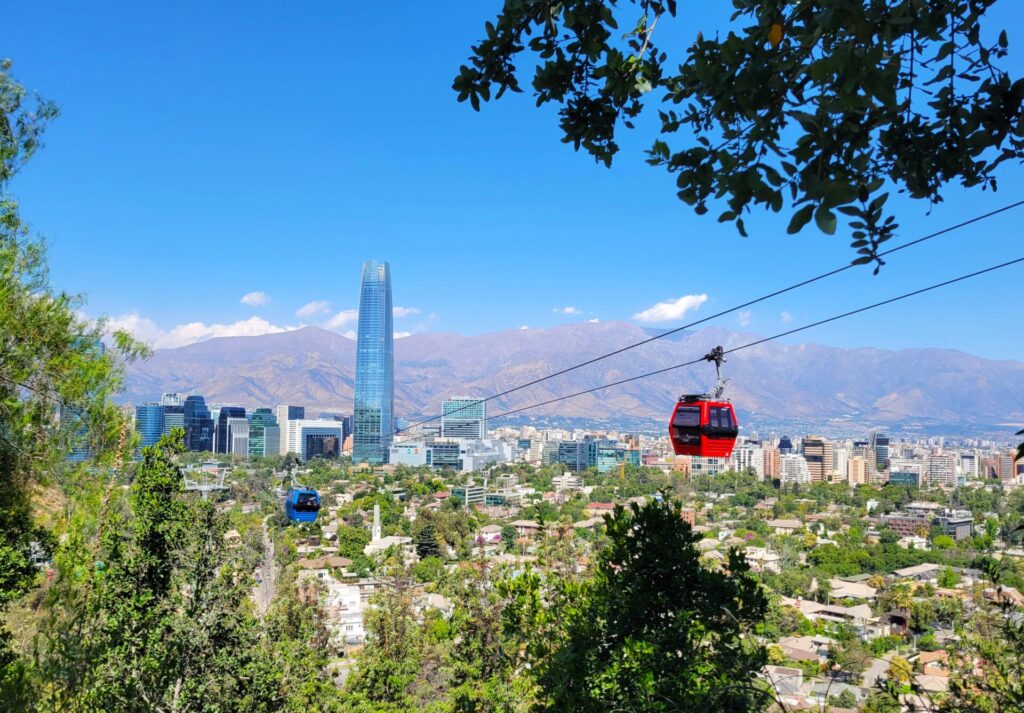
Santiago is a metropolis nestled into a large valley in the foothills of the Andes. It’s an interesting mix of high rise apartments, neglected old buildings, and fancy new construction. Many of the building facades are filled with graffiti and street art, especially in the downtown. There are a number of pedestrian only streets and the thrift store scene is off the charts. The views are almost universally great with giant mountains in most directions. The tallest of which were still snow-capped despite summer temperatures.
Chile was our first stop on our very first trip to South America. We weren’t really sure what to expect with Santiago. Despite being a city of 6,000,000 people, it seems like most people just use it as a springboard to move onto other areas of the country. But we enjoyed our time there, save from a couple of days where the air quality was poor. It offers many of the things we like, such as fresh produce markets, good bread, pedestrian friendly streets, excellent public transit, and abundant street art.
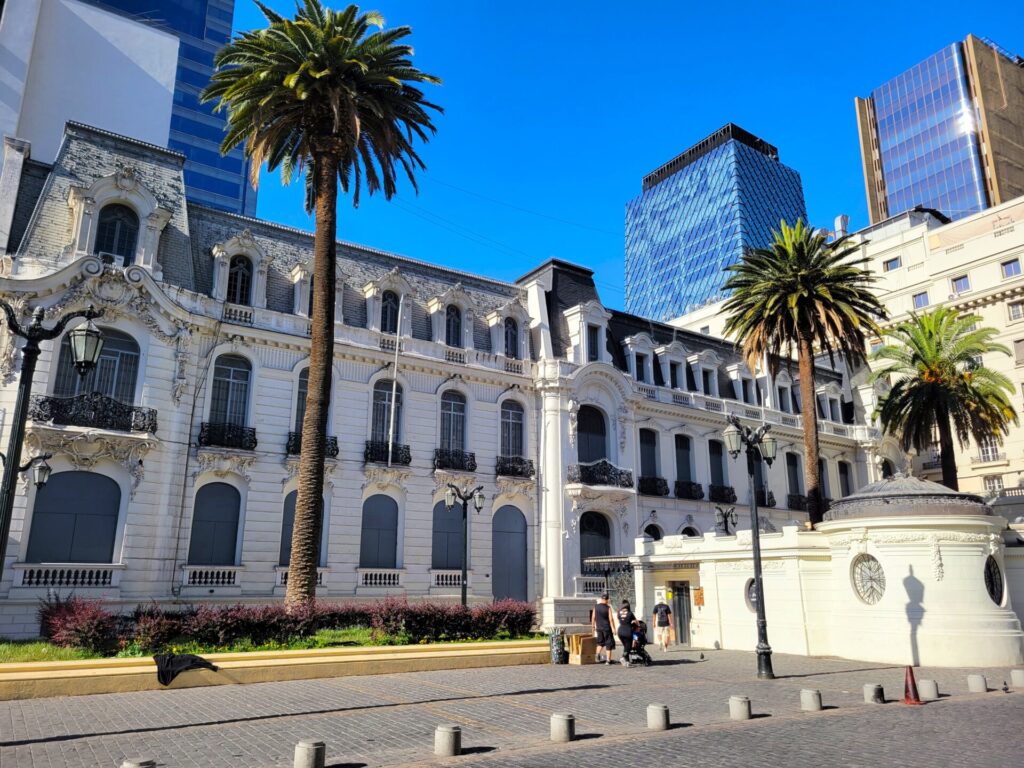
We noticed right away that Spanish is a little different here. Instead of adios or hasta luego, they use ciao. In Mexico, we were always greeted with buenos dias, buenas tardes, or buenas noches depending on whether it was morning, afternoon, or evening. Here it’s all just shortened to buenas. Avocados are no longer aguacates, they are paltas. Hummingbirds are now picaflor instead of colibrí. I’m sure there are a number of other small vocabulary tweaks as well. The Chilean accent (at least in Santiago) is a lot different, so we feel we have a little bit harder time understanding spoken language in general. But it’s not like we were ever fluent, so it’s not a huge difference. We’ll keep working at it.
What We Did
There are a handful of worthwhile museums and we made sure to catch those. The city has a couple of very large parks. The most interesting ones climb into the mountains on the north side and offer sweeping city views. We spent a lot of time wandering through neighborhoods searching for the best street art. We also enjoyed a lot of fresh summer produce, especially cherries and apricots.
Hidalgo Castle
On the Saint Lucia hill in the middle of the city sits the Hidalgo Castle. Well, calling it a castle seems quite the stretch, as there’s barely any structure at all anymore. But it is a really nice viewpoint. The climb can be made in less than a half hour, and aside from some slightly treacherous stairs near the peak, it’s pretty easy to do even on a hot day. There’s also an awesome fountain of Neptune near the entrance.
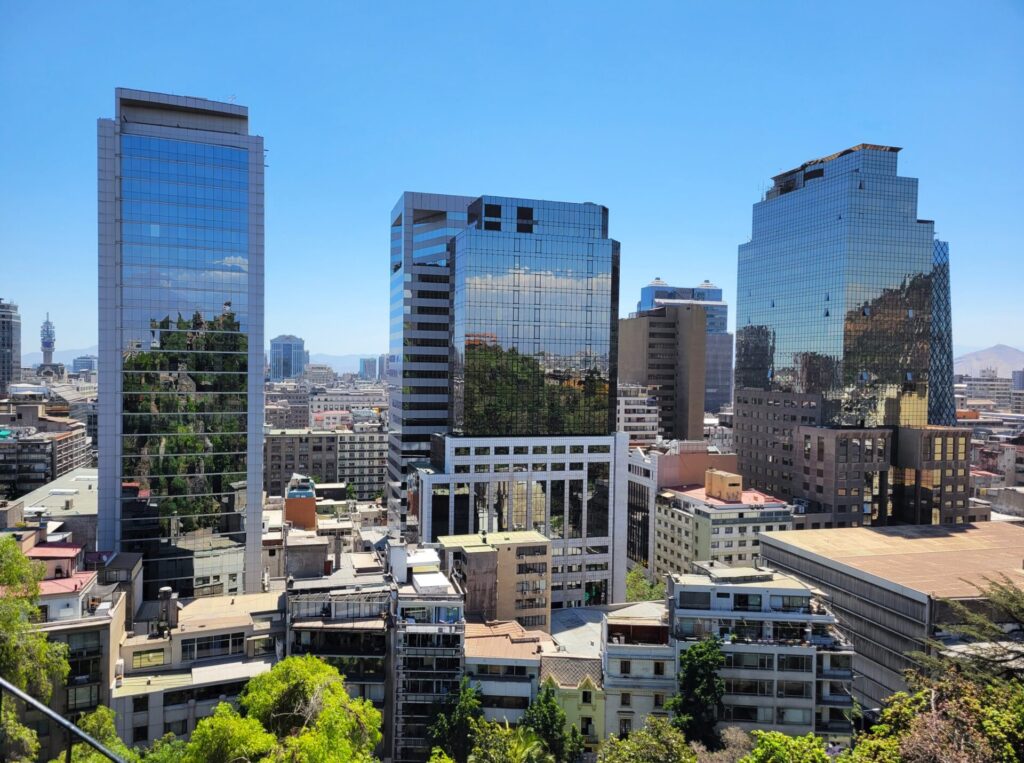
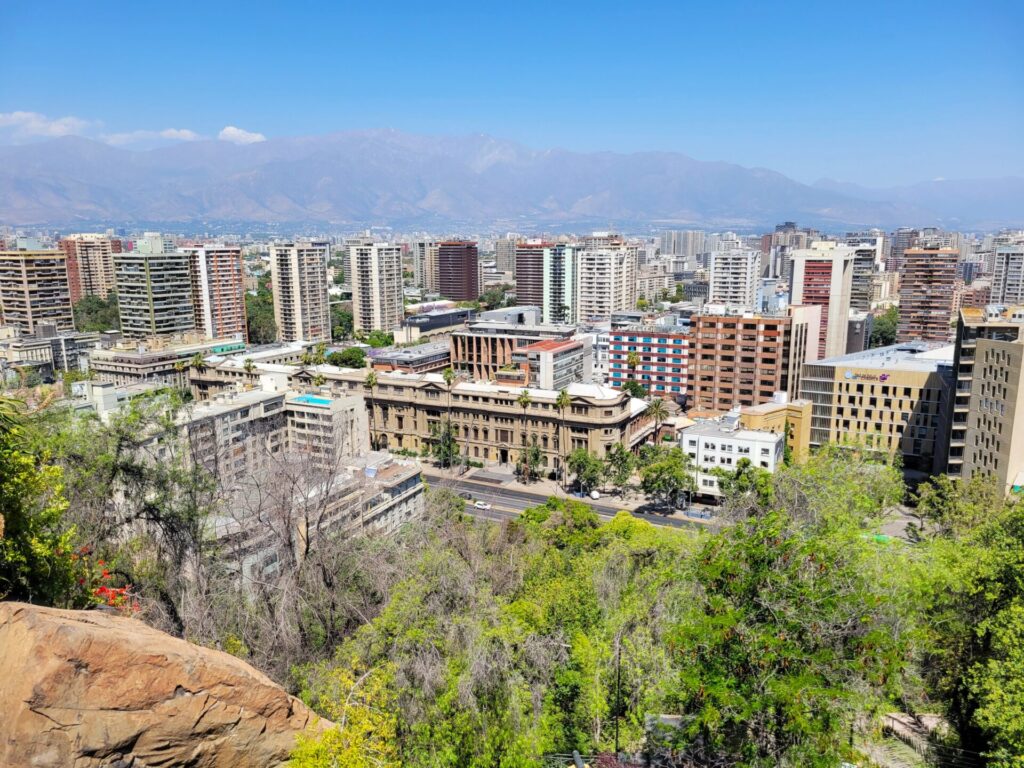
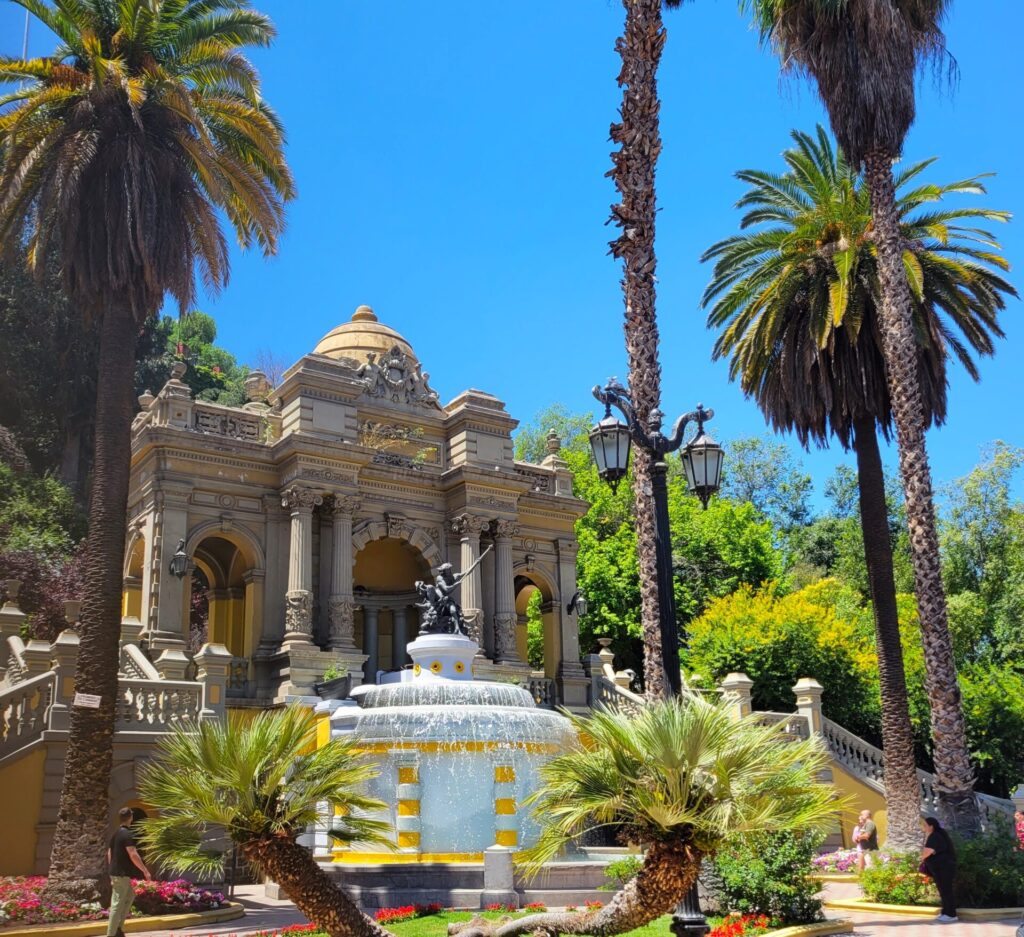
Cerro San Cristobal
While the Hidalgo Castle view is nice, it’s really hard to beat the view from the top of Cerro San Cristobal, or Saint Christopher Hill. This is the closest place to downtown for hiking. There’s a funicular for those that want to skip the hike, but we decided to hoof it. The trail itself is wide and almost entirely uphill, with some sections needing switchbacks. It took us about an hour and 15 minutes to make the trek, which alternates between shade and sun. The views on the way up are nice, but the impressive payoff is at the top. There’s a large religious statue at the peak, and a small church as well. The sweeping vistas of this large city are well worth the climb.
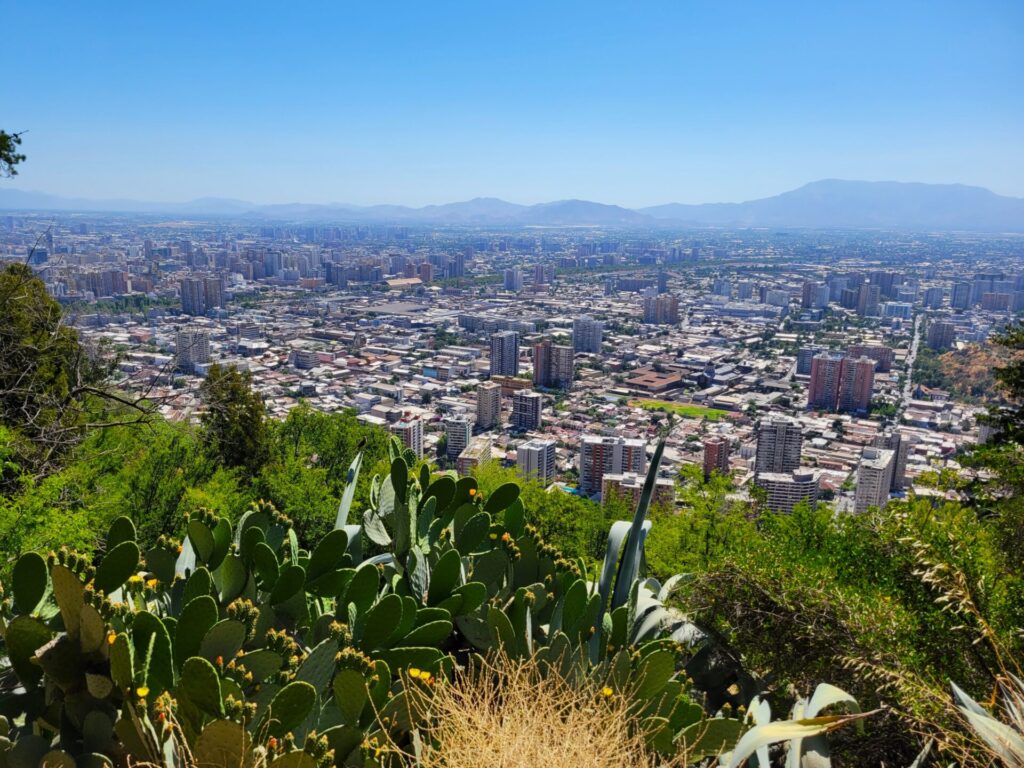
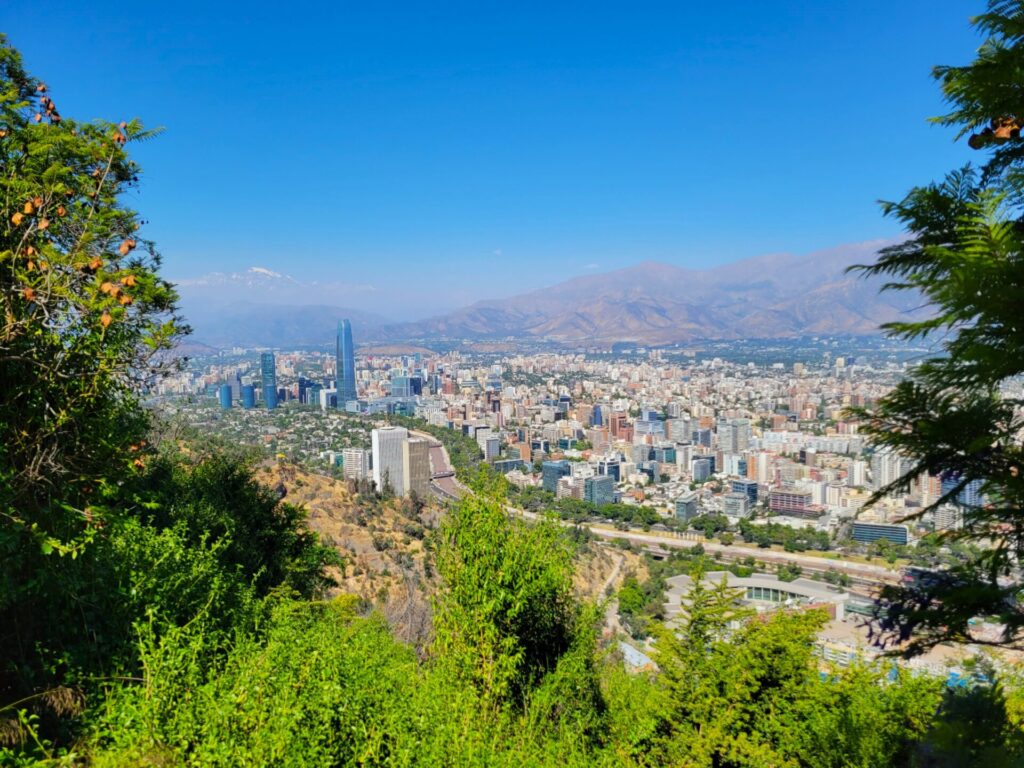
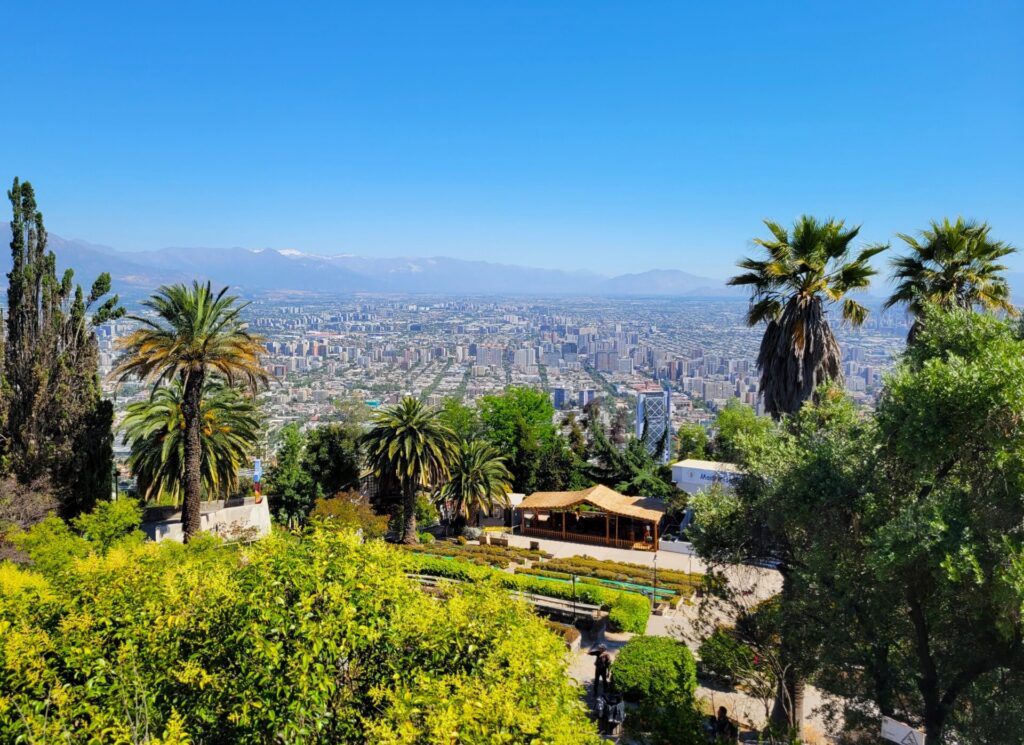
Metropolitan Cathedral
On the corner of the main downtown plaza, the Plaza de Armas, sits the grand Metropolitan Cathedral. Its high ceilings and support columns are filled with ornate marble and stone. This vast house of worship is open to tourists daily and is free to enter. It was a nice respite from the summer heat.
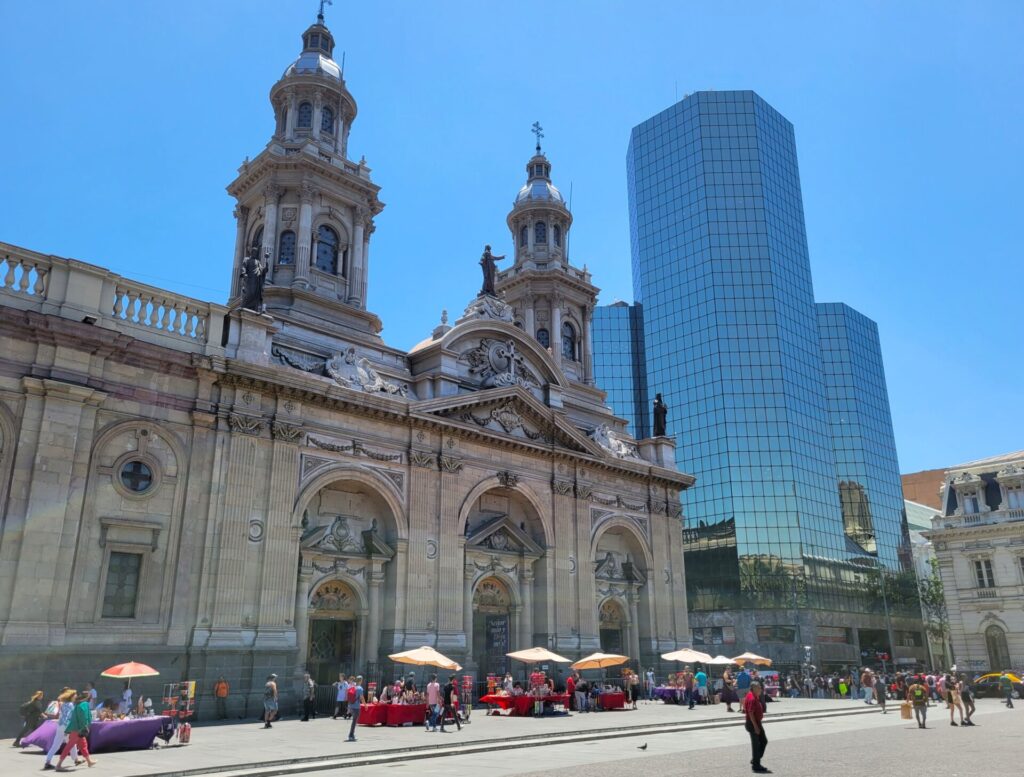
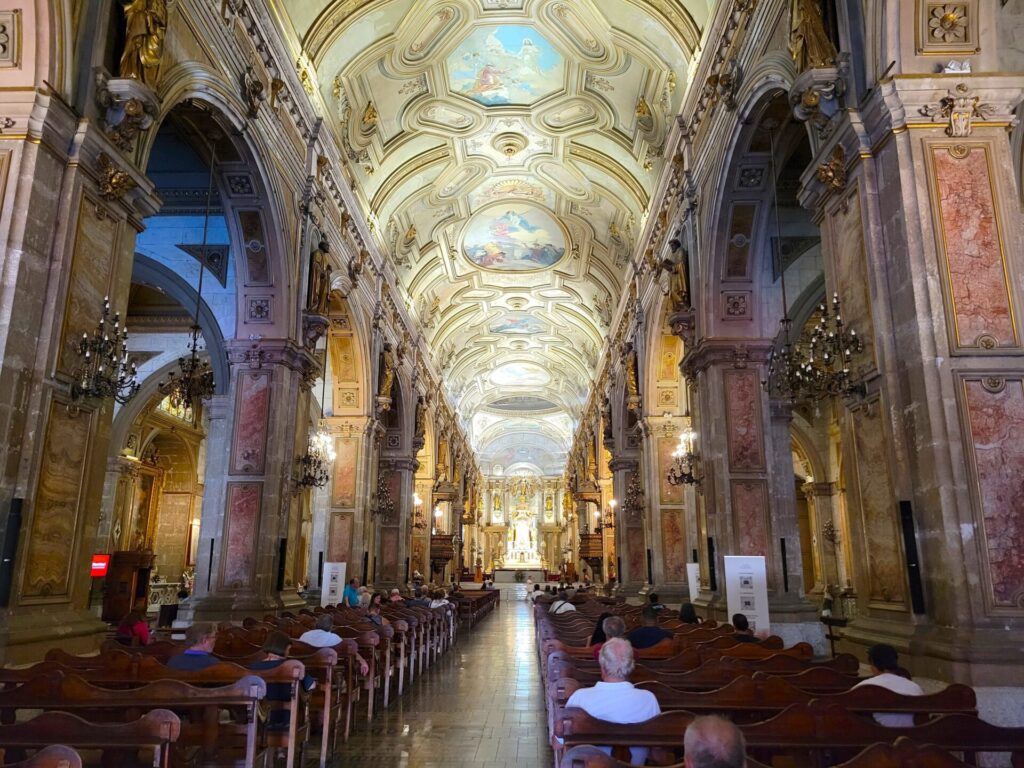
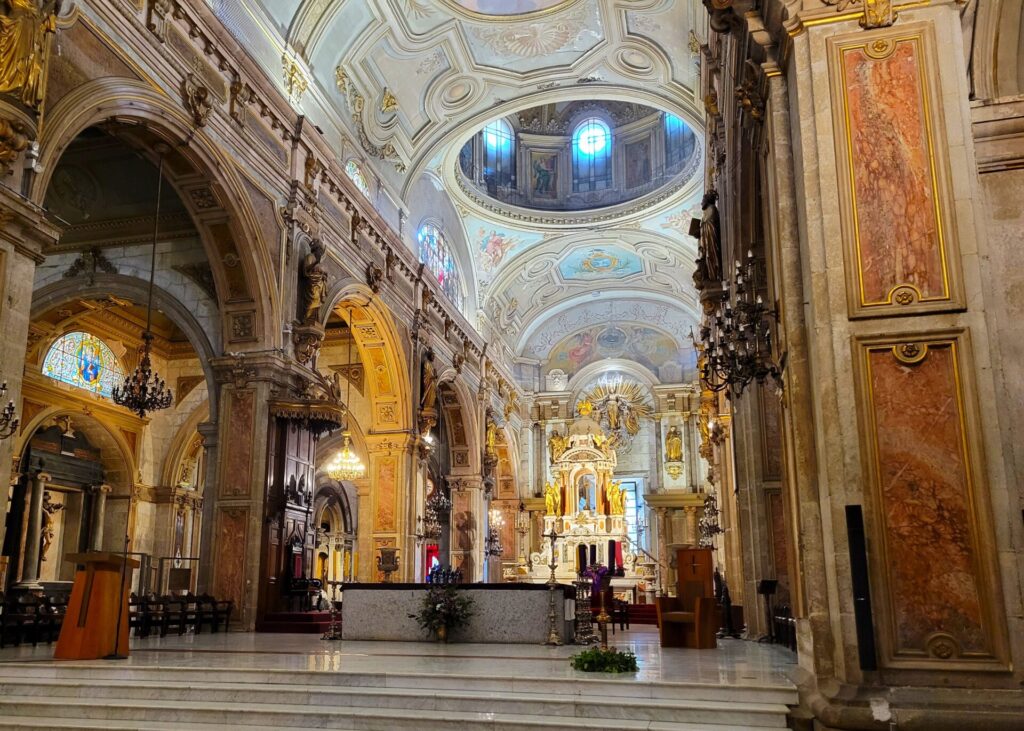
National Museum of Fine Arts
Housed in a really spectacular old building, the Fine Arts Museum focused a lot less on fine art and a lot more on the 50 year anniversary of one of the defining events from Chile’s history. In 1973, the democratically elected Chilean government was overthrown, and with the help of the CIA, dictator Augusto Pinochet was installed as leader. Many of the displays here and around town highlighted that it’s been 50 years since that coup d’état. It was somewhat of a difficult visit, although definitely worthwhile. It can be hard for us to witness all of the damage that our government has done to other countries.
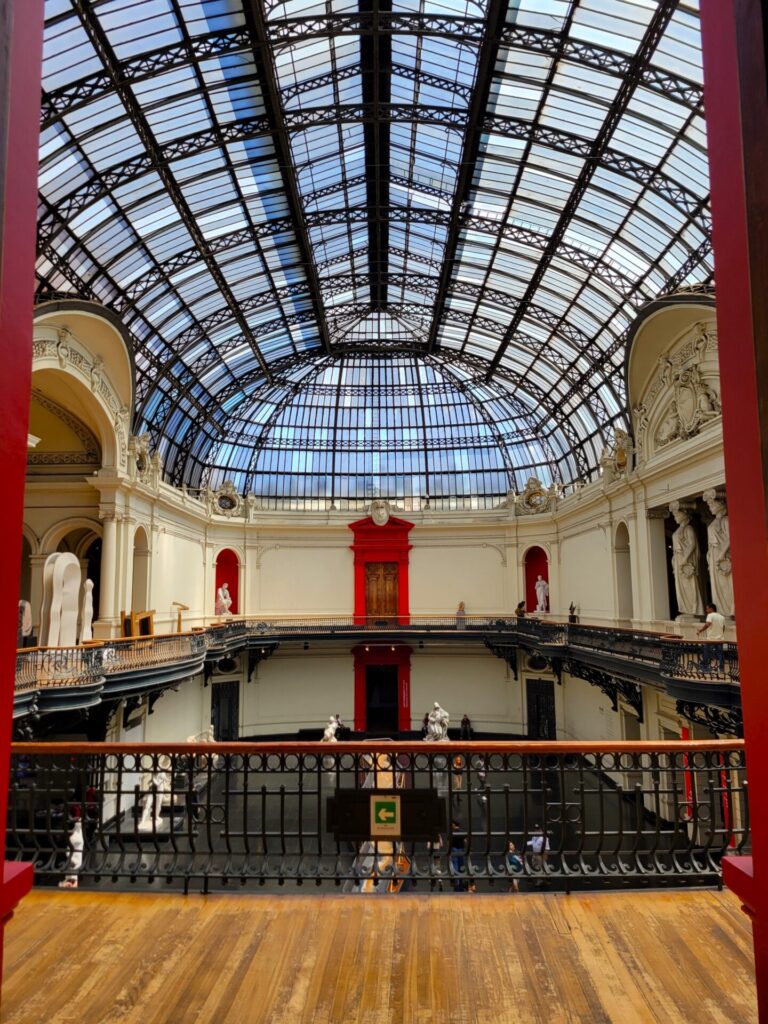
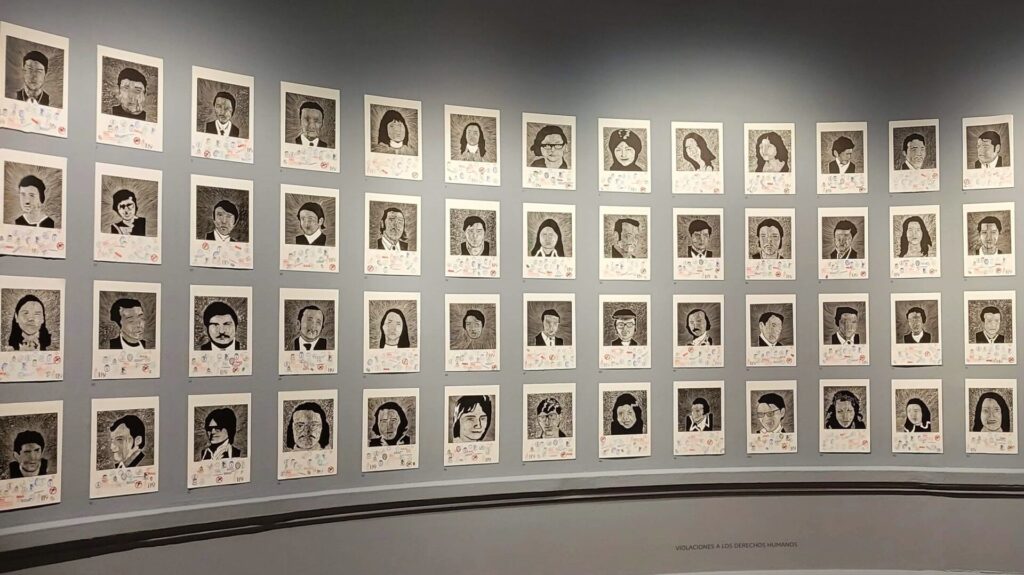
Museum of Visual Arts
The Museum of Visual Arts is a brand new building set just off of a pedestrian street filled with artisan vendors. It’s a small museum, hosting modern art from only a couple of different artists. Despite the modest size, the exhibits we saw were quite interesting and thought-provoking. My favorite piece was simply a bunch of animal bones laid out over a large platform. It was just really interesting to be able to see all of these different skeletal pieces from so many different creatures in one spot.
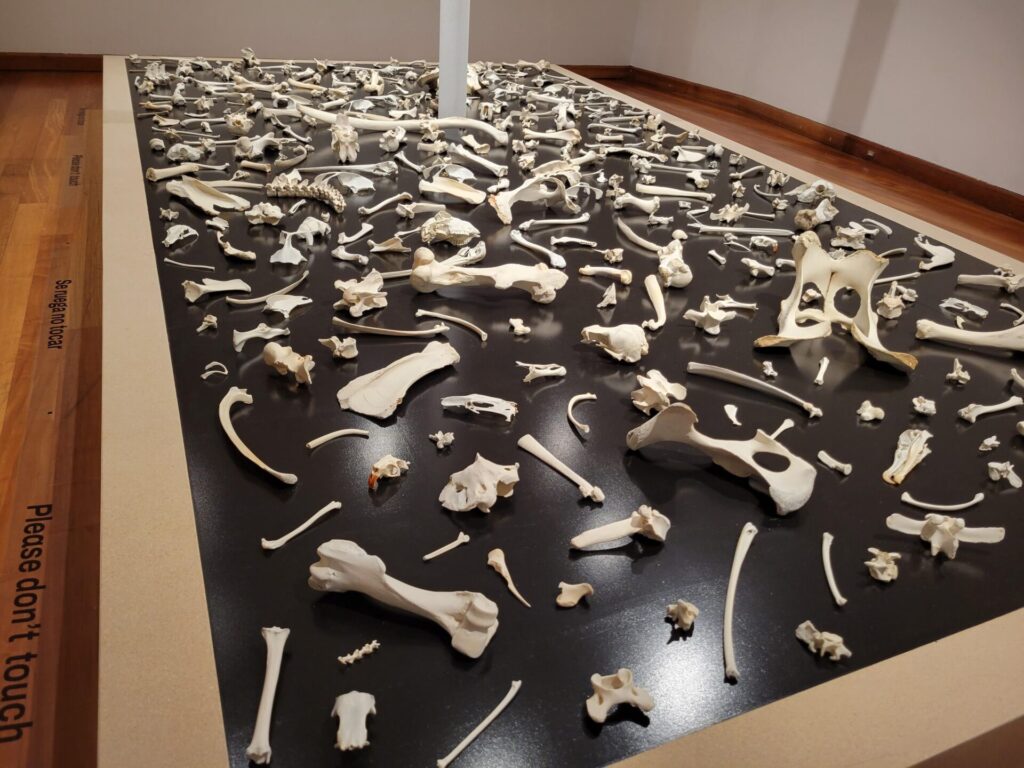
Museum of Memory and Human Rights
It took us two tries to visit the Memory and Human Rights Museum properly. The first time we showed up, we learned that audioguide was only available via a smartphone app. The app itself hadn’t been updated for newer versions of Android systems, so I was unable to download it. We also didn’t bring headphones with us, so I wouldn’t have been able to share Katie’s iPhone guide. So we left to return another day.
The second try we got the tech to work and were able to fully experience the museum. The audioguide ended up being helpful, albeit a little too verbose for my tastes. Nevertheless, this museum is really well made. Its exhibits detail much of the political violence surrounding Pinochet’s dictatorship, including what everyday life was like and how the Chilean people endured.
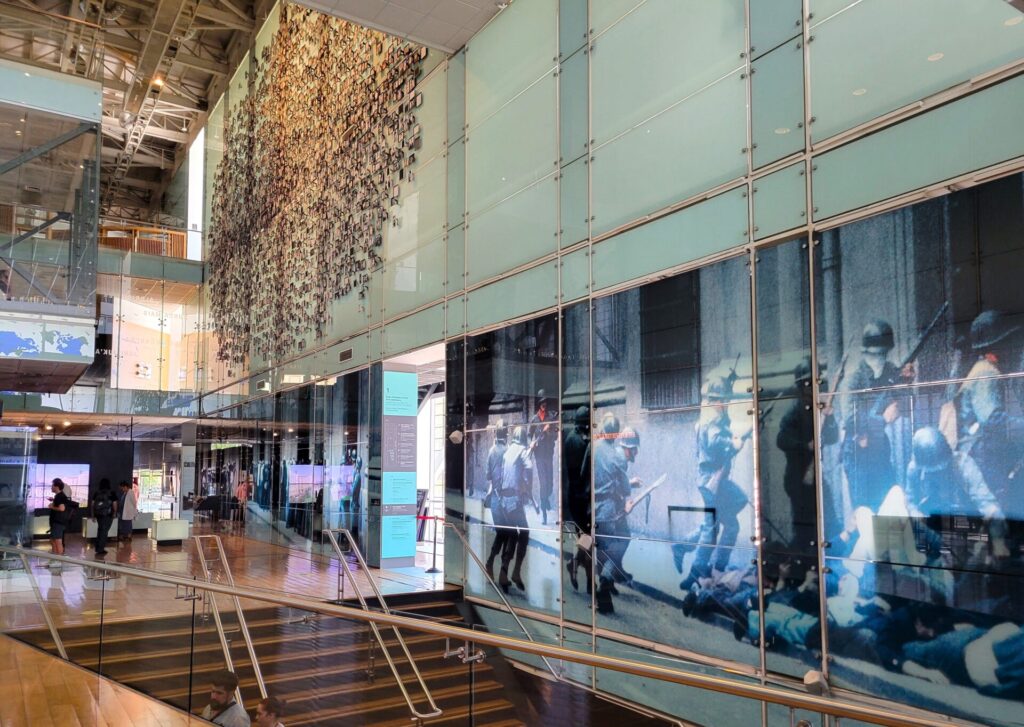
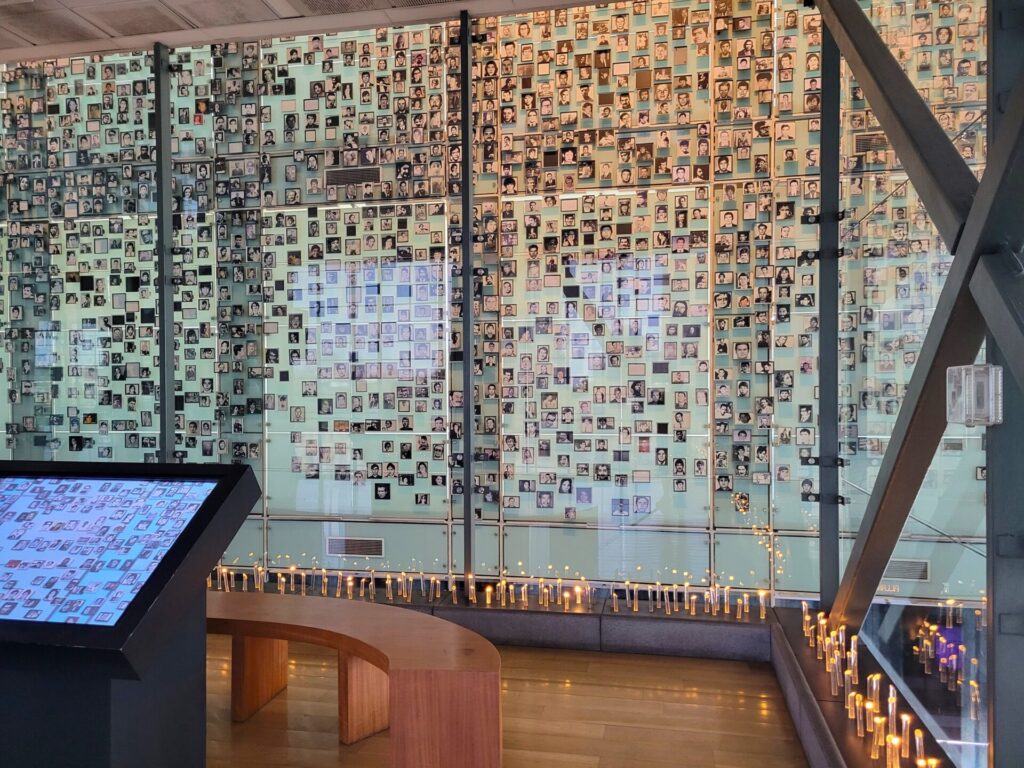
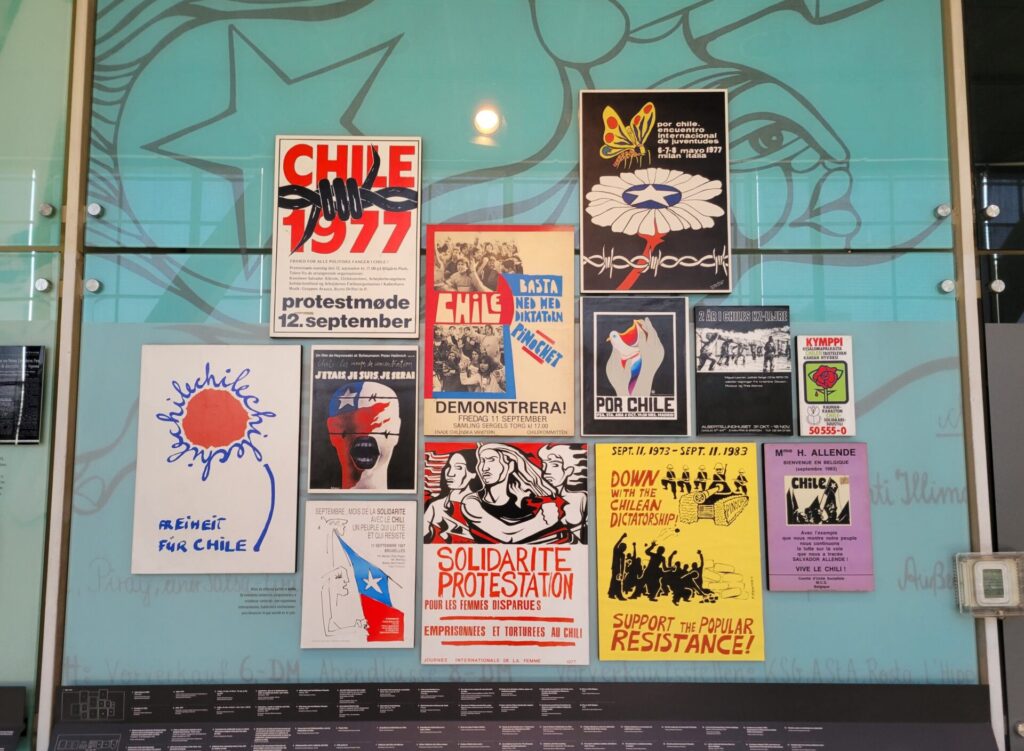
Artequin Museum
On the edge of Quinta Normal Park near the Museum of Memory and Human Rights is the Museo Artequin. The main draw is not the art inside, but the incredible building housing it. It has a very detailed facade, along with a fancy dome and lots of exposed metal. The original structure was built in Paris in 1889 for a World’s Fair. It was then broken down and shipped to Chile where it was reassembled in 1894. Inside is a small museum geared towards children that had replicas of Van Gogh and Gauguin paintings on the first floor, and a second floor where kids could create their own art. The building was quite immaculate and we enjoyed our quick visit.

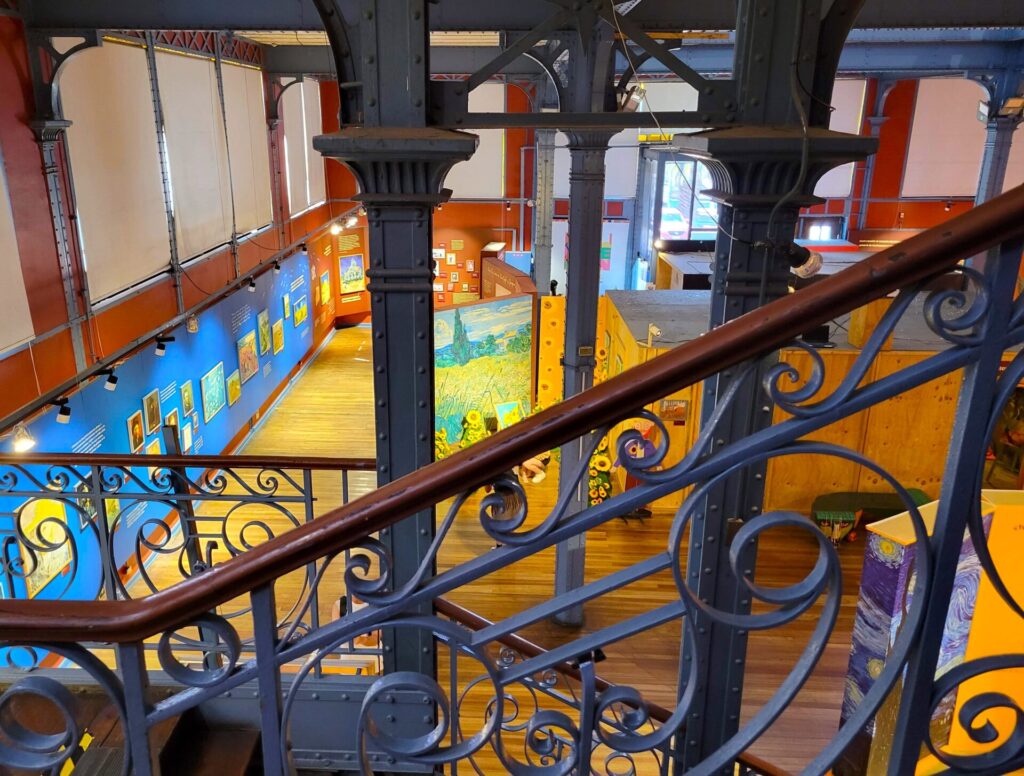

Pedestrian Shopping Streets
Downtown Santiago features several blocks of pedestrian-only shopping streets. It’s a nice mix of small time vendors and large chain stores. We noticed that many of the smaller vendors set up along the streets had displays of bright yellow underwear. Mostly it was women’s apparel, but there were definitely men’s as well. These were being sold everywhere, and it seemed odd, so we had to look it up. Apparently it’s custom in Chile to wear brand new yellow underwear on New Year’s Eve. It’s believed to usher in prosperity in the upcoming year. Judging from the sheer amount of bright yellow underwear for sale, it must be a pretty popular tradition. This is one custom we didn’t participate in though, hopefully not to our detriment.

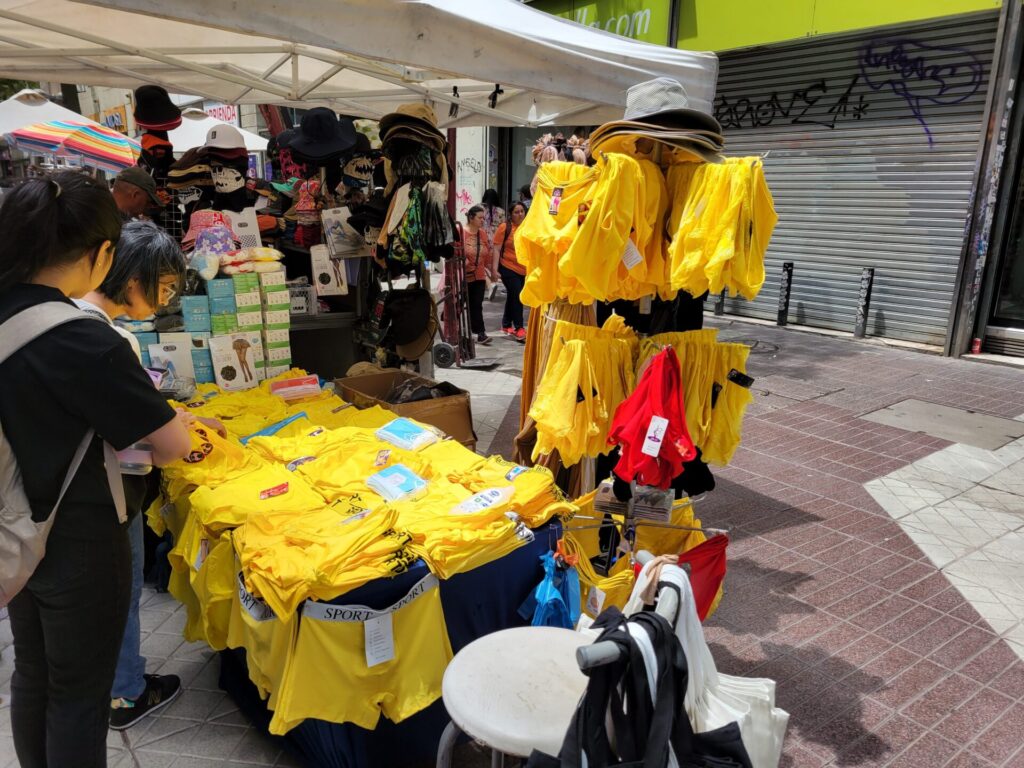
Thrift Stores
Santiago is chock-full of thrift stores. They are in just about every neighborhood, but downtown really has a huge inventory. There’s even an entire street (Paseo Bandera) filled with one thrift store after another that goes on for multiple blocks. There must be three dozen or more. These stores have all sorts of styles, from hiking clothing to army surplus to sports gear to beachwear.
It was really bad timing that we didn’t learn that Santiago is a thrift store mecca until we arrived. Coming from the US, we showed up in Chile with our wardrobe pretty much fully stocked. If we would’ve known how awesome and plentiful their thrift stores were, we definitely would’ve held off on some US clothing purchases.
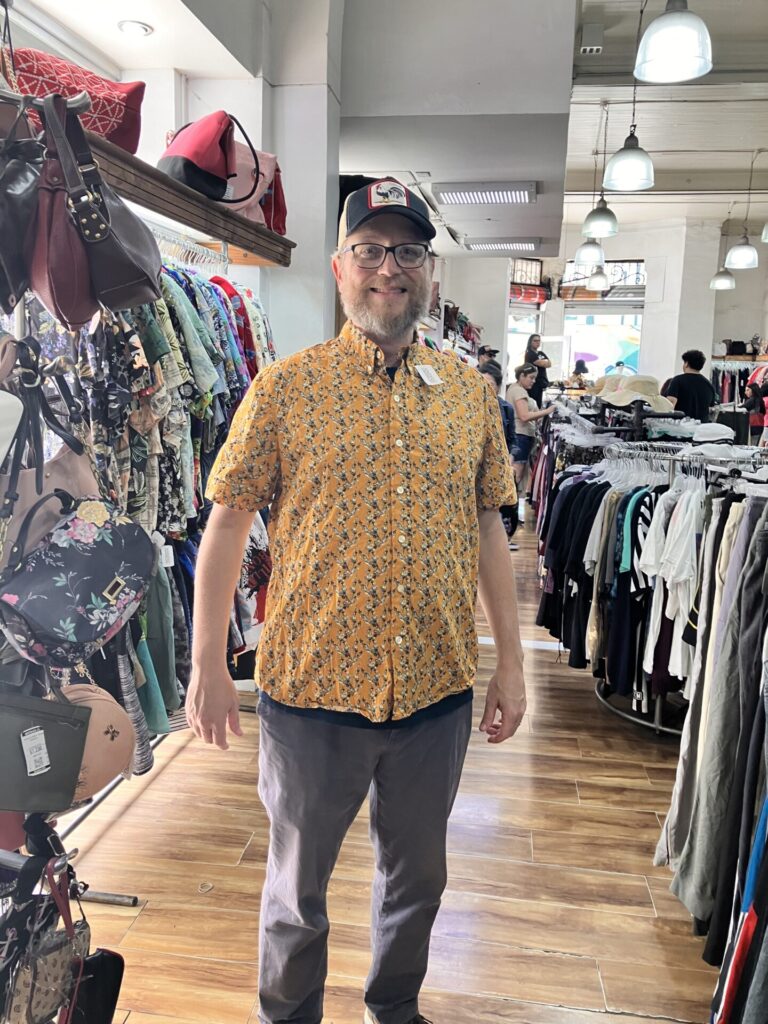
Summer Produce
Our visit coincided with the start of summer here in Chile, and we took full advantage, especially in the fruit department. My favorite was the abundant cherries, which we found everywhere for incredibly cheap prices. Street vendors have overflowing mounds of these fresh, ripe delicious beauties that they sell for 1000-1500 pesos per kilo, which is the equivalent of about $.50-$.75 per pound. We also bought a ridiculous number of apricots, which we ate often for breakfast with some homemade granola. The ones we didn’t eat directly were turned into apricot bread pudding, which did not disappoint.
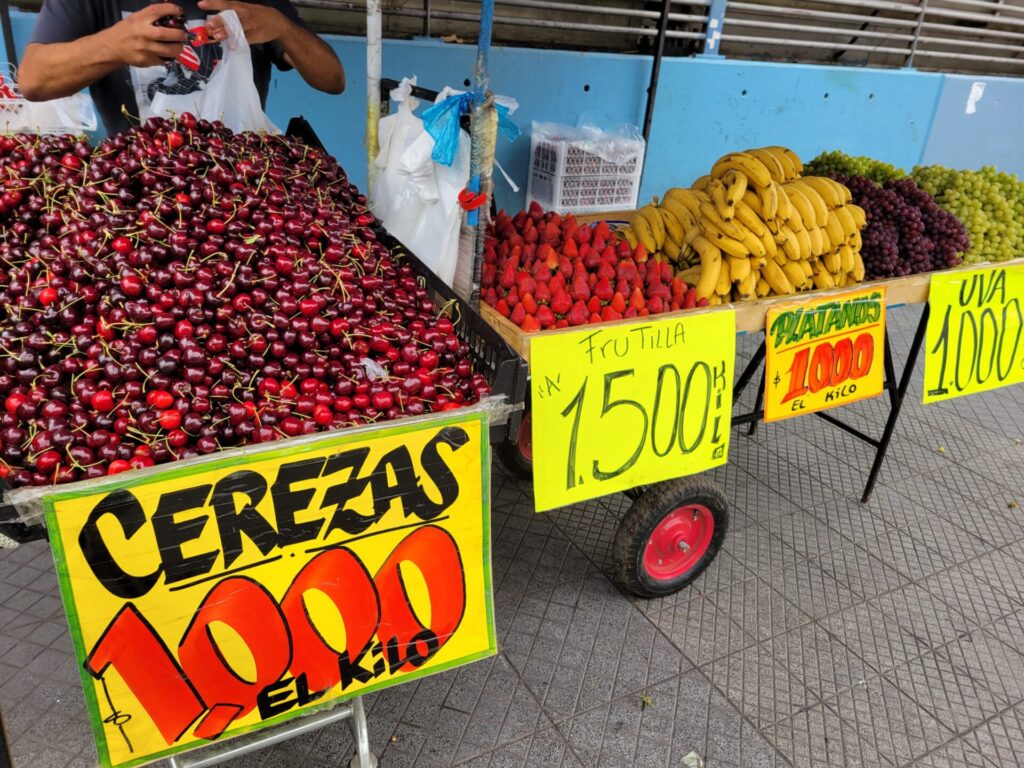
Speaking of food, we found a bakery that has the best bread that we’ve had in years. The loaves had an amazing crust and had a slight sourdough base. They were a little under $4 each, which I think is a good deal for a large top of the line artisanal loaf. We bought 7 or 8 of them during our stay. The grocery stores do pretty good with bread too. They often had nice ciabatta sandwich buns still warm from the oven.
Street Art and Mosaics
The vast majority of building surfaces and solid fences in Santiago are covered with graffiti or other street art. There was so much that I had to make a separate post about it. The regular art was really good, but I was most impressed by mosaic pieces. Some of them were so detailed and gorgeous.
Costanera Tower and Neighborhood
The Providencia neighborhood has many skyscrapers, but they are all dominated by the Gran Torre Costanera. At 980 feet (300 meters), this building is the tallest in South America. It also houses the largest mall in South America, although we skipped that experience. The surrounding neighborhood is quite modern and new, offering a nice contrast from the downtown area. It’s full of new buildings with unique shapes.
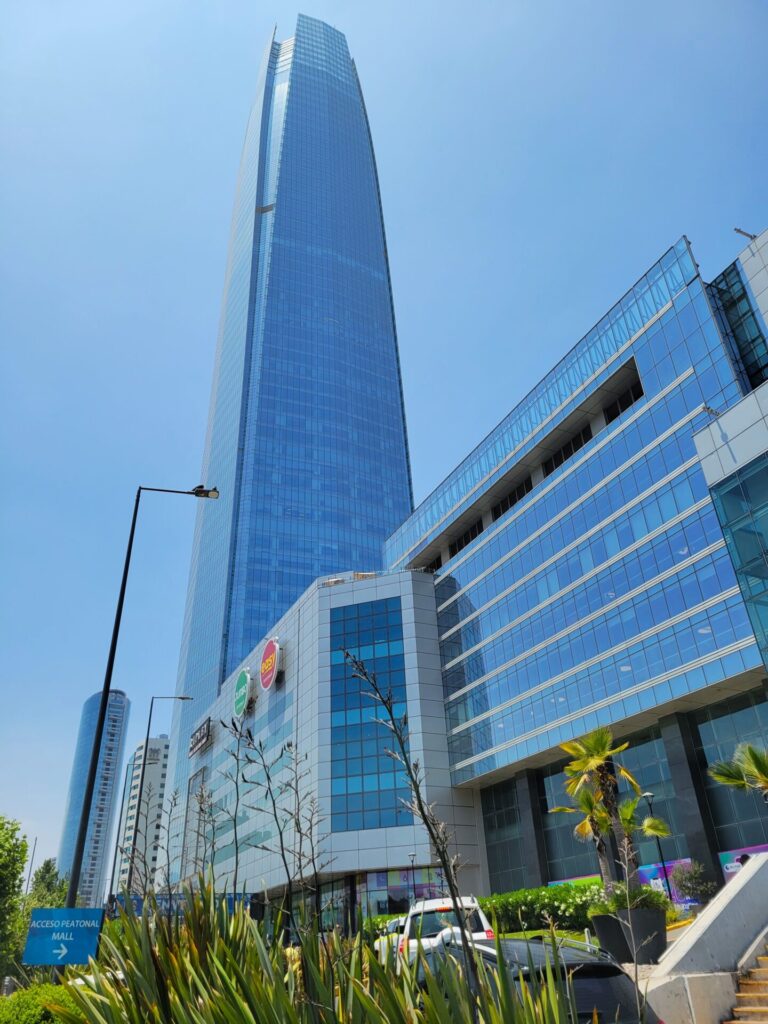
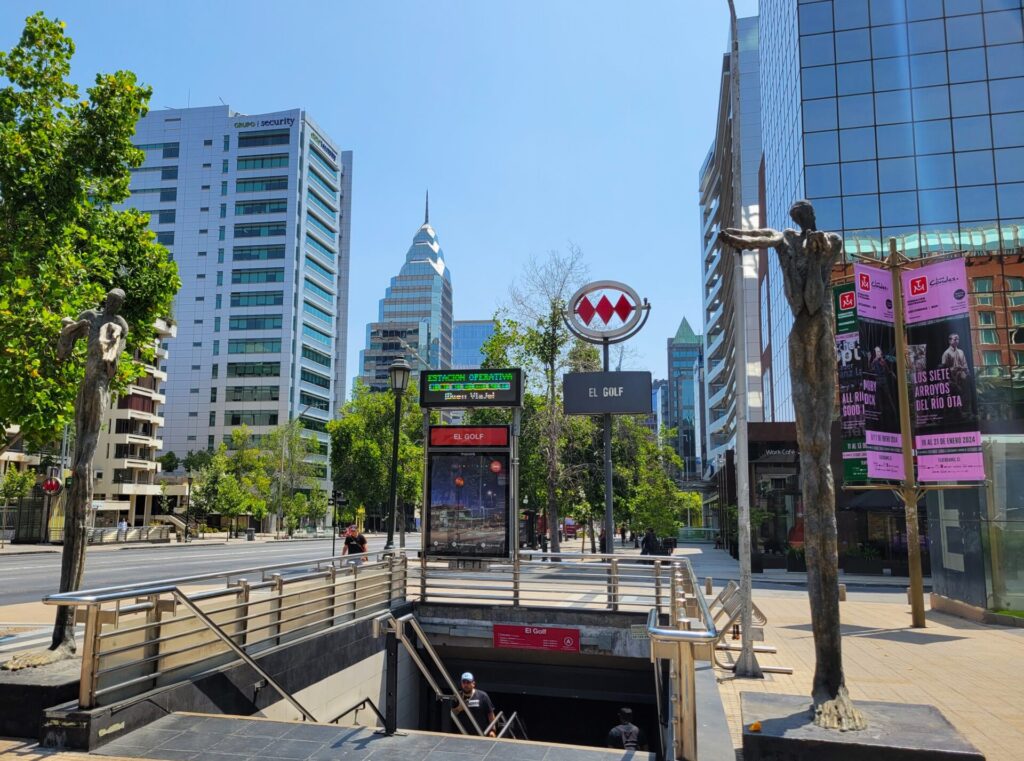
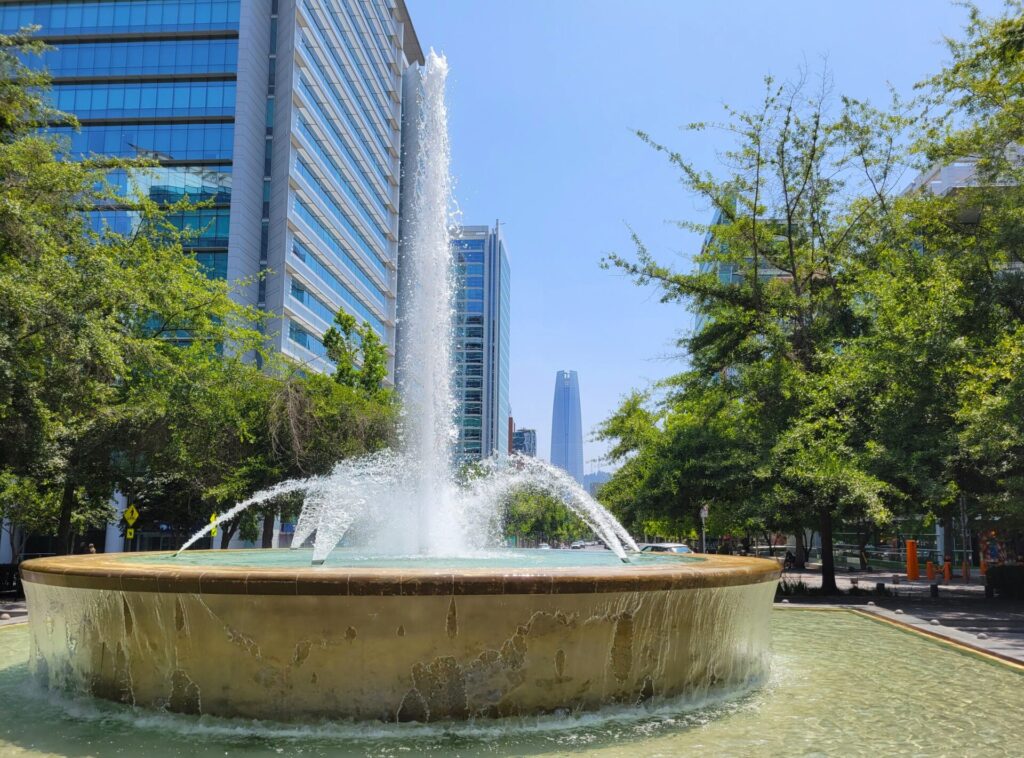
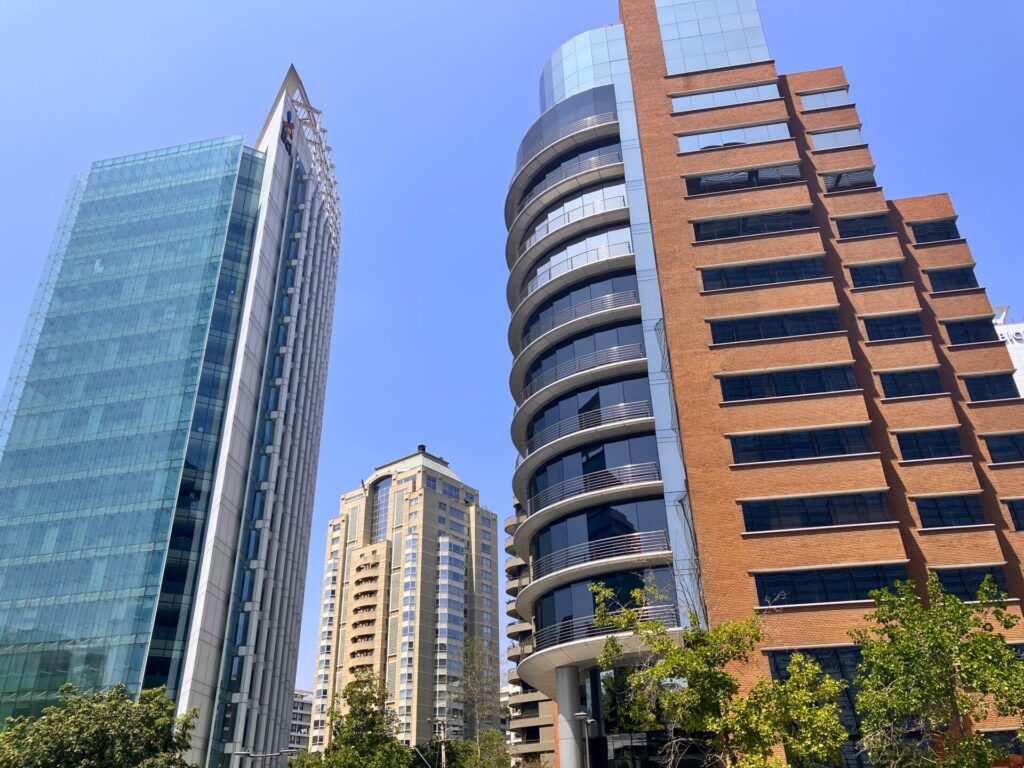
Botanical Garden
Part of the large Metropolitan Park on the city’s northeast side, the Jardín Mapeulemu botanical garden showcases a great variety of native plants and trees. These are separated into three regions within the space covering the north, central, and southern parts of Chile. The park is built into a hillside, so the interesting flora comes with great views of the Costanera Tower and new skyscrapers as well.
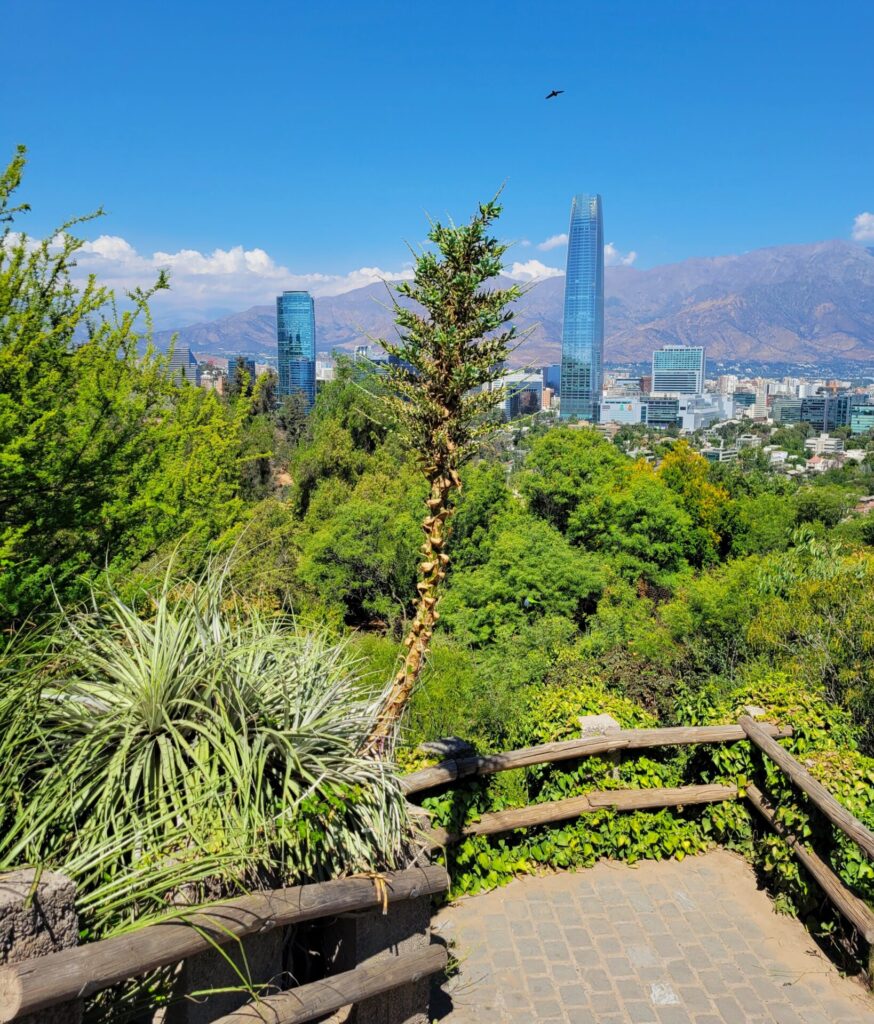
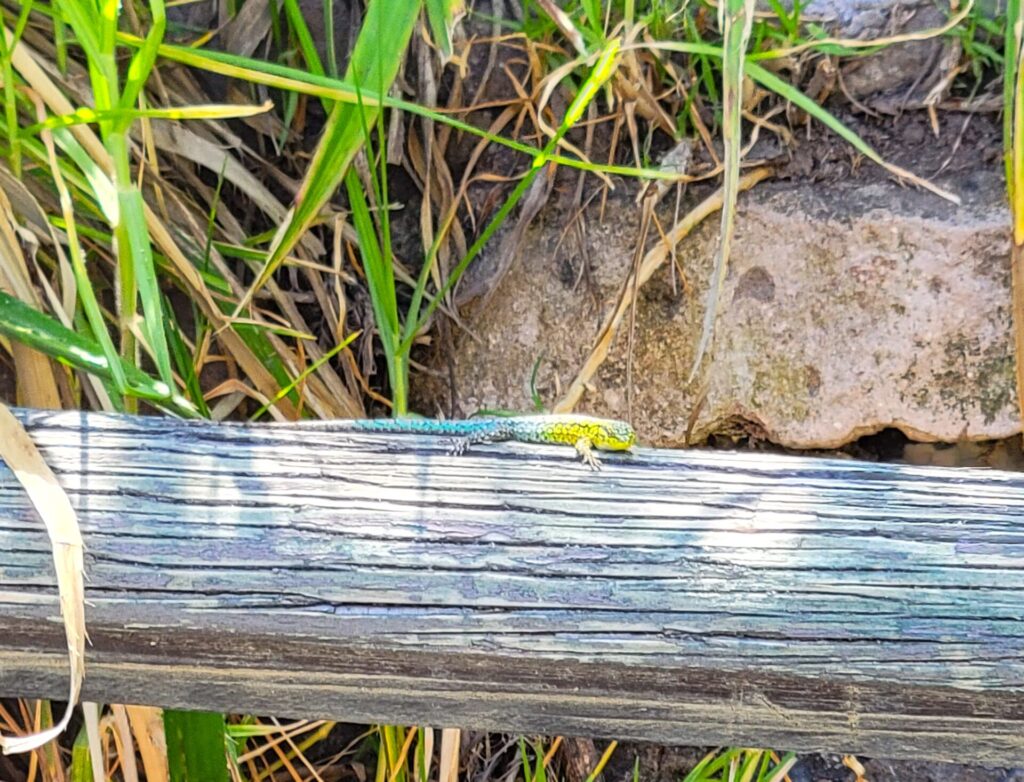
Japanese Garden
Close to the botanical garden is the Japanese Friendship Garden. It is a popular place within the Metropolitan Park to gather on nice days. It’s reasonably well kempt with small waterfalls and ponds with koi. The main attraction is probably the skyline views though. It’s free and worth a quick stop on the way up to the botanical garden.
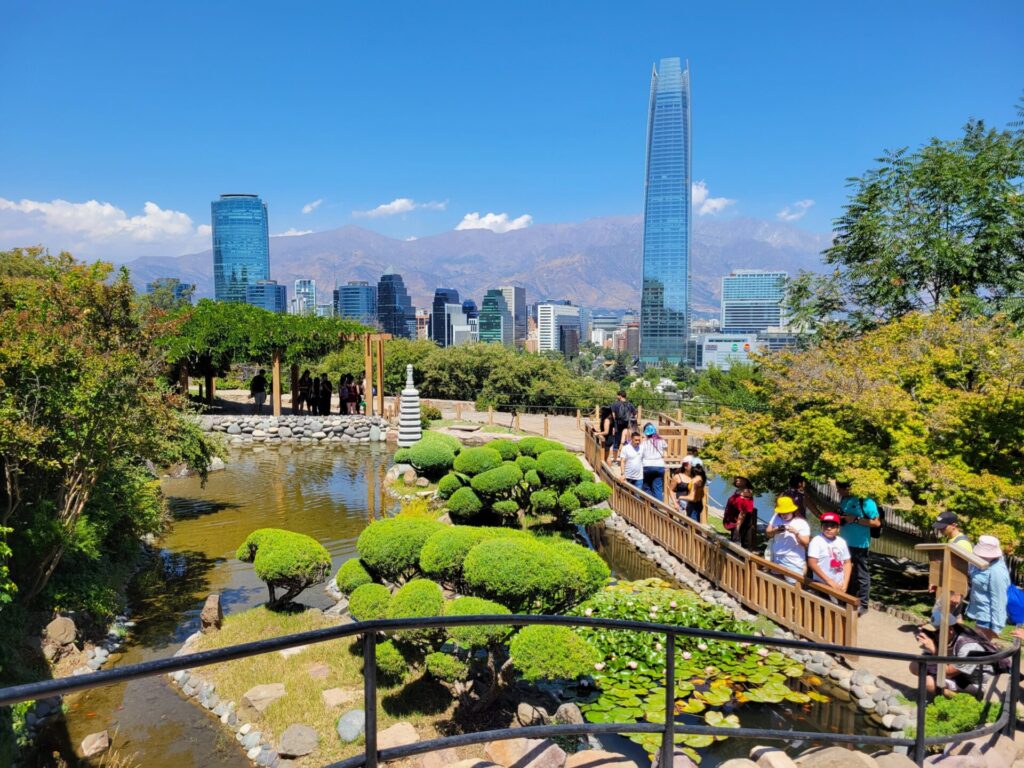
Warnings About Safety
Once while walking to a far off grocery store, we stopped and moved off to the side of the sidewalk to check the map. A man walking his dog came up to us, identified himself as a policeman, and told us to be careful of phone snatchers on motorbikes. Another time in a different section of town, coincidentally also on the way to a grocery store, a lady warned Katie to be careful with her purse, as apparently people have been stealing bags. She was already wearing it cross body, so I’m not sure what else she was supposed to do. We are normally reasonably careful with our things, and are cognizant about not walking down the street while staring at our phones anywhere in the world.
Considering that we were being cautious both times that the warnings happened, it’s hard for me to tell if it’s a real problem or if residents just want to make sure that tourists aren’t soured by a bad experience in Santiago. I saw plenty of locals being way more careless with their phones than we are, so I have to believe it’s more of a “just be careful” type of warning. But we are in South America, and theft is certainly more of a risk here than in some of the other places we’ve traveled. Nevertheless, we’re now trying to keep it in the forefront of our minds to be extra careful to look around before whipping the phone out for that great picture.
Where We Stayed
We rented a modest one bedroom apartment in a high rise building near the Barrio Italia neighborhood. The apartment was on the 5th floor and had windows on two sides creating a nice cross breeze. It was so nice that we only turned the AC on a single time during our stay, despite a few days reaching into the 90s. It was a dry heat, and like a California summer, we didn’t see a single drop of rain during our stay. We liked the neighborhood enough, although I think staying closer to the Costanera building would’ve offered a little better park access.
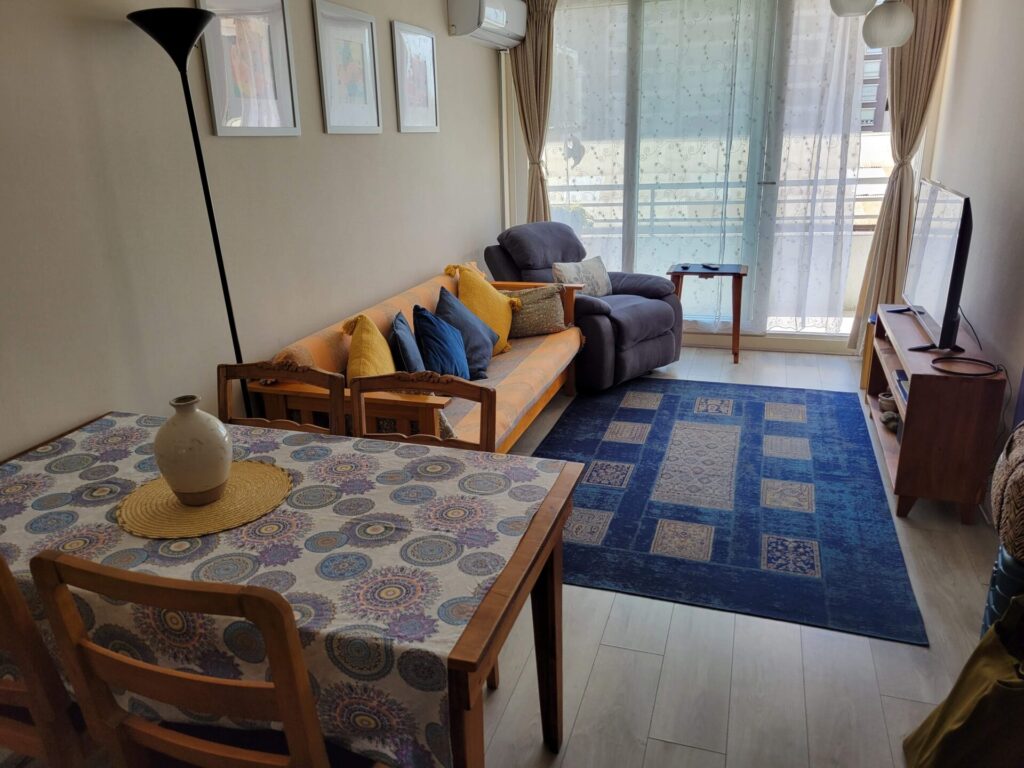
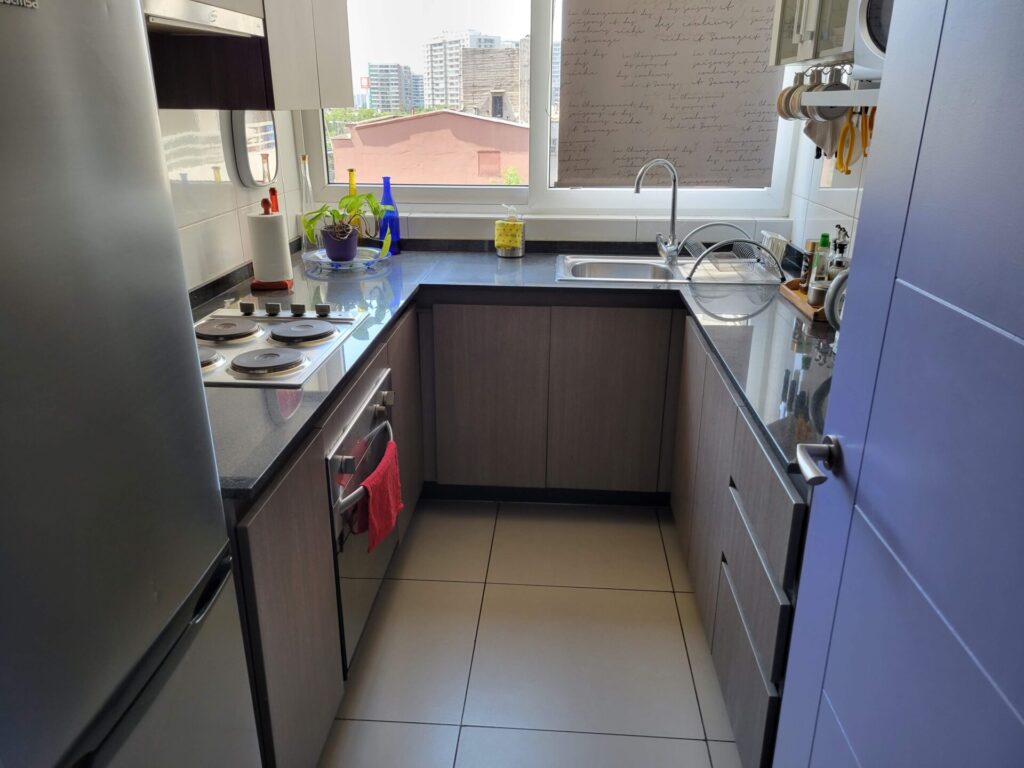
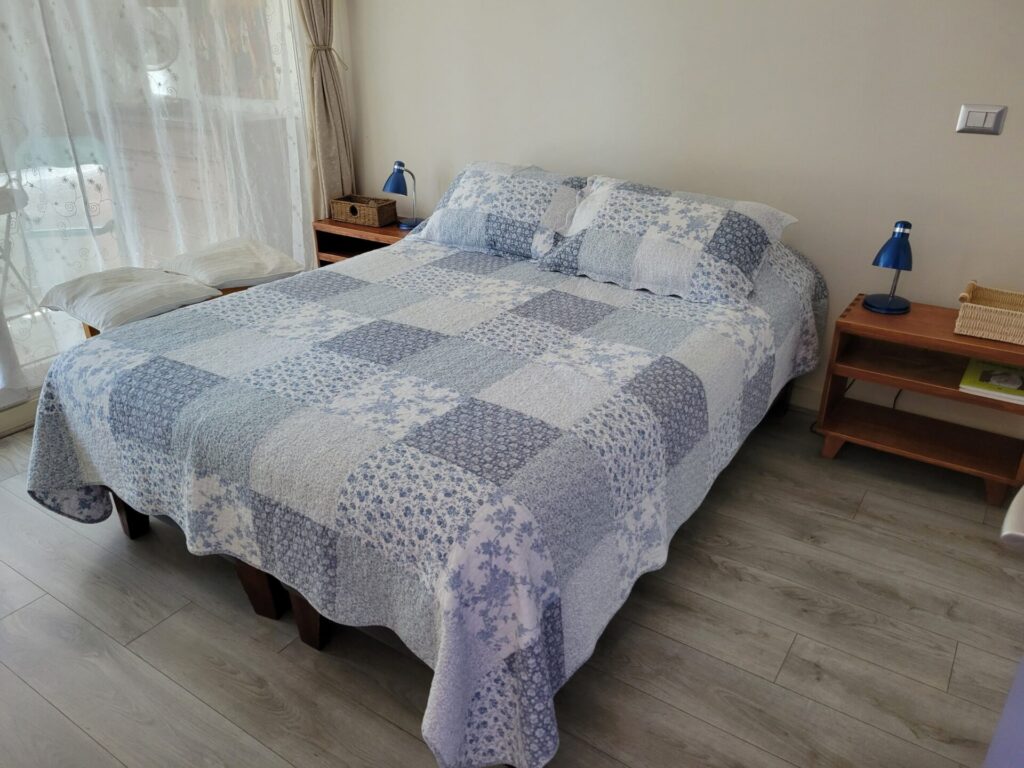
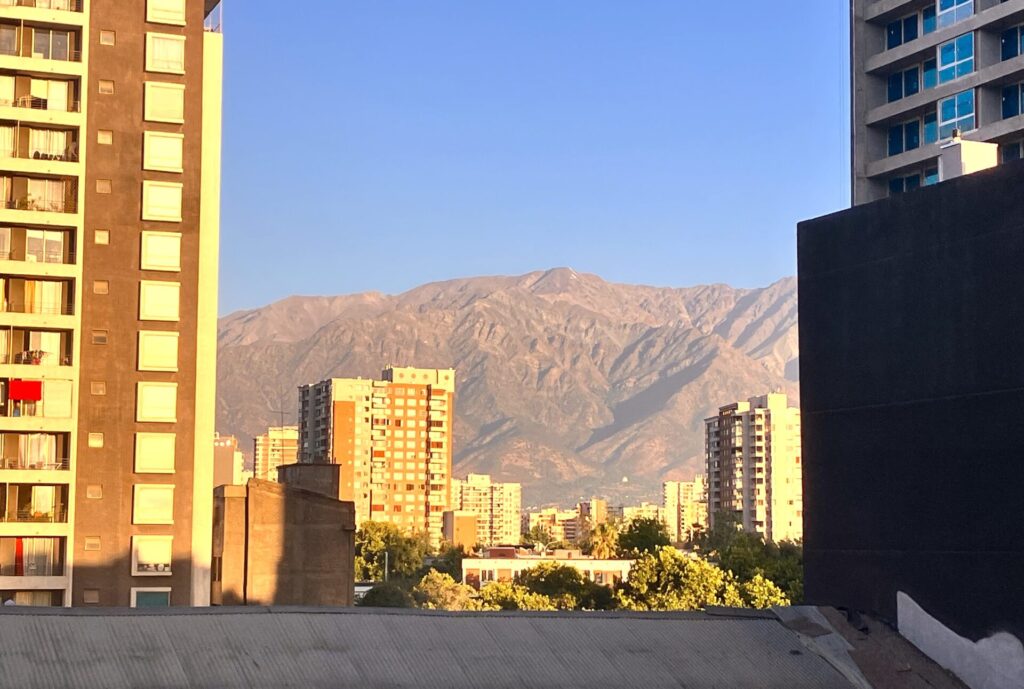
What We Spent
Our apartment felt a little expensive at $1443 for 32 nights, but everything else seemed reasonable. Most of the museums and parks were free. And it was hard to beat the prices on those cherries and other fresh fruit. We cashed in some airline miles, like we do for most long haul flights, so our travel expenses to get here were minimal. Overall we spent $2642 during our stay in Santiago. Adding in our regular bills for things like insurance and mail service, our grand total for the 32 night stay was $2892, or $90/day.
Overall, we both found Santiago to be an interesting city. Catching glimpses of the surrounding mountains never got old. We enjoyed a lot of the urban hiking that was available. Our timing was good, as the summer produce was outstanding, and the temps were never hot enough to make it unbearable. The street art was plentiful and a nice compliment to all that Santiago had to offer. It was a nice start to our South American experience.
Great post and thanks for sharing – next loaf of artisanal bread is on us..! Was it a credit card accessible or cash based city?
Hi Ryan,
The street fruit vendors only take cash, but other than that, I think card was not only accepted but preferred at most places.
Just discovered your blog. I’m inspired by what you’ve done and are doing. I’m taking a similar FI path with the same plans to slow travel around in the next few years with my family. So you’re pretty much living out my dream right now. I really appreciate you sharing your costs to help with my own forecasting. You don’t know how much that helps me and reduces stress.
How was the street food scene out there? Did you guys use the metro often to get around? I’ve been out to south america but never that far south. As spanish speaker I had a really hard time understanding Colombians. Argentinians are probably the hardest to understand in my opinion…so if you’re headed that way it only gets more challenging/fun.
Bienvenidos Noel!
Glad we can provide some inspiration. And thanks for the heads up about Argentinian Spanish, as we’re headed there after Chile. I think the good part about having poor Spanish skills is that I don’t expect to understand much of it, so it’s usually just a nice surprise when it clicks. If it doesn’t, then it’s just normal. But I accept the challenge.
There really isn’t much of a street food scene in Santiago. There are a number of small hot dog joints and empanadas for sale, but that’s about it. We did use the metro a fair amount and found it to be clean, fast, and efficient.
What was the bakery with the good bread?
Hi Anna,
I hyperlinked it on Google Maps above. It’s simply called La Panadera. It’s here.
Its not just a great summer town. Go back in the winter and you are a short drive away from some of the best alpine skiing in the world! And you can ski in August since the seasons are reversed from what we experience in the Northern lattitudes.
Hi Steve,
We’re not skiers, but we definitely enjoyed the backdrop of those great mountains from the city. The only thing I’d be worried about for a winter visit would be the air quality. I think Santiago struggles with that most of the time in winter. But of course that’s not a huge factor if you’re immediately leaving the city on a ski vacation.
Stumbled on here after seeing a comment on Reddit. Great blog and glad you enjoyed Chile! I studied abroad in Valparaiso many years ago – loved it. Such a great country and people. Enjoy the next adventure!
Hi Greg,
Thanks for stopping by. We’re in Valparaiso right now and also enjoying it. I’ll have a post up this month.